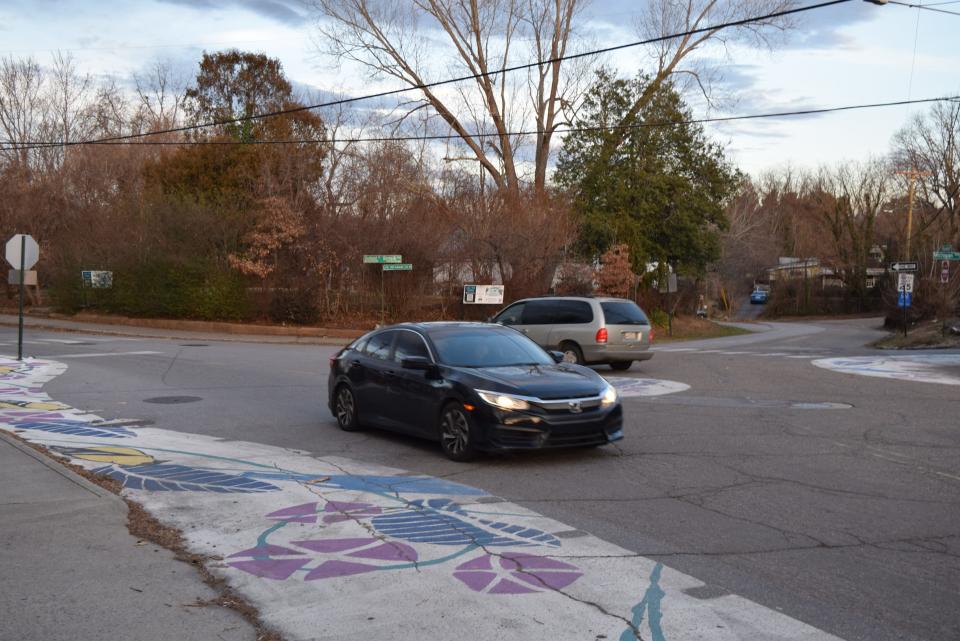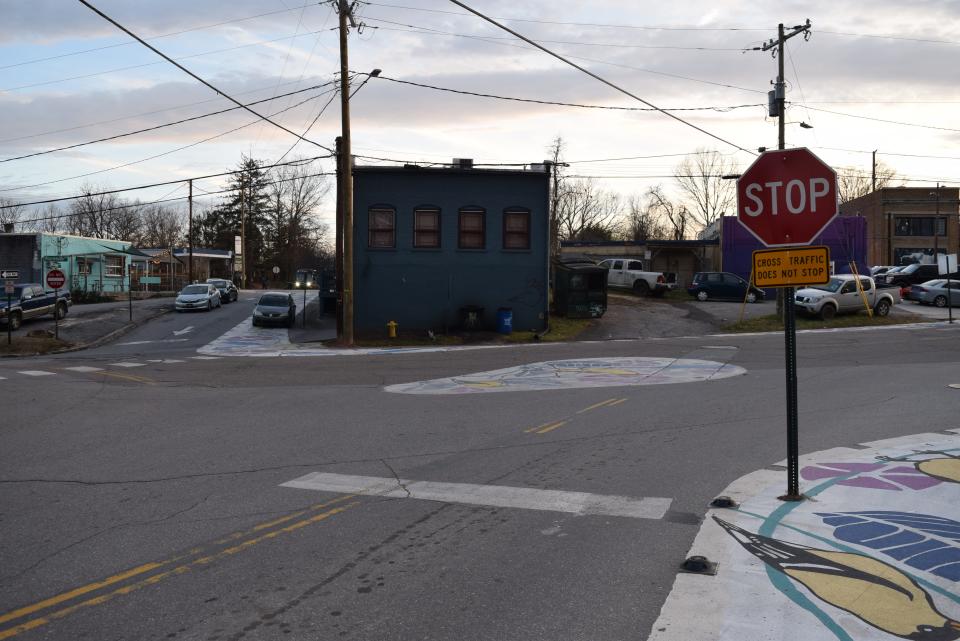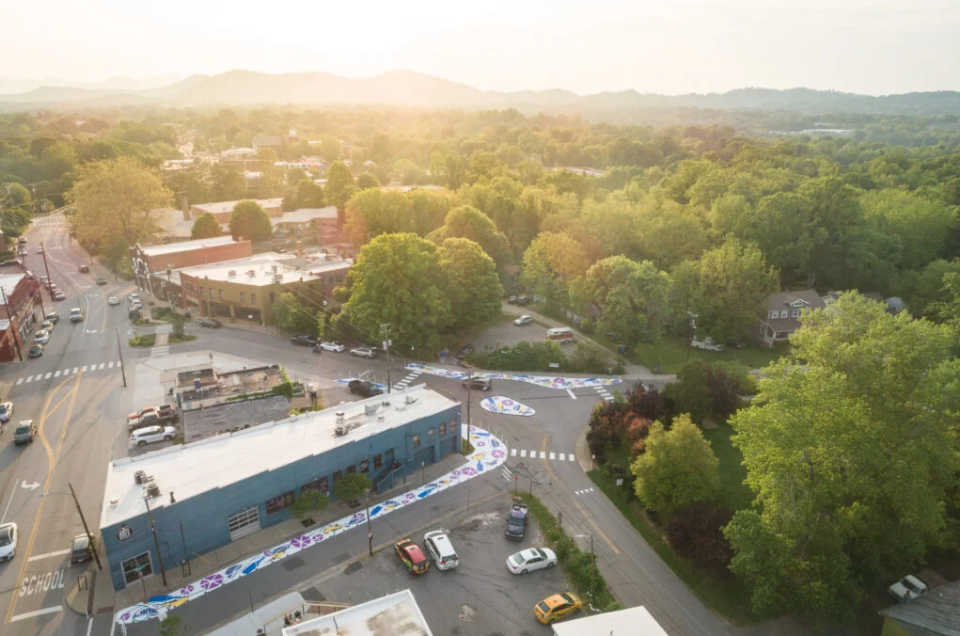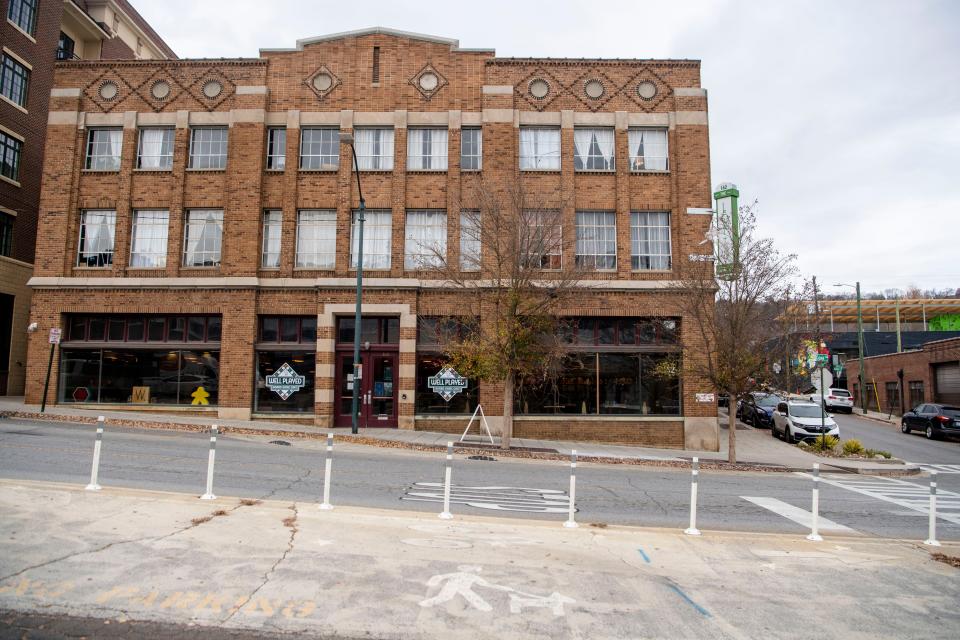Asheville Answer Man: Westwood-Waynesville intersection a roundabout? What do I do?
ASHEVILLE - Today's burning question is about the bright and colorful "traffic circle shaped" mural painted in the Westwood Place and Waynesville Avenue intersection. Is it a traffic circle? A through-street? To roundabout, or not to roundabout, that is the question.
Got a question for Answer Man or Answer Woman? Email Executive Editor Karen Chávez at KChavez@citizentimes.com and your question could appear in an upcoming column.
Question: I have a question about a local traffic intersection. Recently the city painted a pretty circular floral design in the middle of the large intersection of Westwood Place and Waynesville Avenue in West Asheville. The shape suggests it should be used as a traffic circle but the lack of a curb or siding allows people to just drive straight through it. Also, the southbound drivers on Westwood Place tend to ignore the stop sign they have (as they would at a traffic circle). Can we get some clarification on whether this is supposed to be a traffic circle or a through street?

Answer: I also have this question, reader. As I make my usual weekly trip to spend an hour or so in Harvest Records, I often find myself at this intersection — sometimes in a gridlock with other motorists.
Well, it's not so much a gridlock as a car-to-car stare where our eyes say: "Hey! Who has the right of way?"
I experienced this car-to-car stare again when going out to visit the intersection the afternoon of Jan. 8, where I parked up the street and recorded some car behaviors from 5:25-5:35 p.m. It felt like 'peak traffic hour.'
Beyond several cars failing to yield to pedestrians or bicyclists, many rolled through the Westwood Place stop sign. I recorded 18 cars interacting with the stop sign during this period, where eight cars performed a rolling stop or just didn't brake at the stop sign.
However, of the 34 cars I recorded interacting with the mural, 23 — 67% — seemed to respect the 'mural roundabout.' So, while I believe my data is somewhat incomplete, it seems there is evidence for confusion about this location, despite many following the oblong mural roundabout. I would've stayed longer, but my fingers were cold and Harvest Records was calling.

'Once upon a roundabout'
To answer your question: it was, at a recent point, a volunteer-installed traffic circle. After a year-long period of experimentation, the city has asked for a return to its former status as an intersection.
The mural and traffic circle were courtesy of volunteer efforts through Asheville on Bikes and the AARP, which make up part of the Street Tweaks team — a group of local organizations dedicated to "making public spaces more accessible, safe and functional for all users," according to the Street Tweaks website.
Mike Sule, Asheville on Bikes executive director, said the traffic circle was installed after community dialogue about the intersection, where the traffic circle proposal received support from the East West Asheville Neighborhood Association and West Asheville Business Association. The intersection had been chosen for the project for its size and frequent use.
Dangerous roads 'He would stop for anybody': Asheville family mourns loss of man killed on Sweeten Creek
Pedestrian death: Pedestrian killed on I-240 near Haywood Road in Asheville; APD investigating collision
Additionally, as motorists use Westwood Place as a shortcut to I-240, the traffic circle intended to slow traffic passing through the area, where drivers can often speed straight through the intersection.
"If you are a motorist, and you drive this frequently, you're able to just blow right through it," Sule said. "The result of the project sort of encourages the motorist to slow down, take a look, pull your head out and look left and look right. You know, be a more conscientious driver."
Both Westwood Place and Waynesville Avenue are city roads, meaning the city has to maintain and determine future use types. As such, Street Tweaks established a year-long memorandum of understanding with the city to install the circle.
The mural, extending along Westwood Place and Michigan Avenue, was not meant to just be pretty or as a compliment to the roundabout. It was intended to serve as a "sidewalk extension," Sule said, allowing pedestrians to more safely navigate the area just next to the heavily trafficked Haywood Road.
Did the 'tactical urbanism' project work?
AVL on Bikes conducted a survey on the project from the period of time it was installed in 2021 to the memorandum's expiration in 2022, where those in the area could scan a QR code to express their feelings about the project. Biking and walking survey respondents found the additions had made the area safer, Sule said.

"Those who were walking or biking thought it was very much improved," Sule said of the survey.
"Motorists most often found it inconvenient and confusing — that was the general feedback," he said.
Anecdotally speaking, Sule estimates a 60-40 split on those who use the remaining mural as a roundabout and those who use it as a typical intersection. Your Answer Man's amateur data collection supports as much.
The confusion displayed how the materials for the project were not to last. Near The Walk restaurant on Michigan Avenue, bollards had been installed to help facilitate pedestrian traffic where a staircase partially blocks a sidewalk adjacent to the road. Instead, the area became parking.
"Well, the bollards proved not to work." he said. "Cars would say: 'Hey, this is a great parking spot.' And they would just run over the bollards and park here."
I spoke to Mike Capon, the co-owner of Harvest Records, who expressed a similar sentiment regarding motorist confusion.
"I appreciate any effort to make roads safer for pedestrians, cyclists and cars," Capon said. "Unfortunately, the car people really just ignored it."

In fact, many decided to just run over the rubber perimeter of the traffic circle leading to significant wear and tear and subsequent removal of the rubber curbing.
Since the end of the MOU, the city has asked for the removal of the mural, bollards and rubber curbing as to return "pre existing conditions," Sule said. Currently, the only remaining element of the traffic circle is the mural.
"Part of the approach of tactical urbanism is to experiment and try things and see what works and what doesn't work," he explained. "And the rubber curbing that we used was not of a quality that could sustain."
With city help, Street Tweaks has put out a request for proposals for the mural removal, but the team has not yet received a response.
Sule's hope is dialogue about the intersection will continue, where improved materials and design could provide for further safety at the location.
"If the city was like: 'Hey let's take what's working and let's swap it out' — we would be interested in supporting that," he said.
I reached out to city spokesperson Kim Miller and Interim Transportation Director Jessica Morris about the future of intersection. Currently, it seems there is no information to share about the future of the intersection.

What's 'tactical urbanism?' Coxe Avenue project?
Sule noted efforts to increase pedestrian safety come as Asheville has historically seen the most pedestrian deaths per capita in the state of North Carolina. Five traffic related pedestrian deaths were recorded in the city in 2023.
Tactical urbanism is a way "we can go out and we can create more predictable scenarios" with community support, where projects don't have to be "a million dollar investment," Sule said. The tactical urbanism experiments allow the city to "to test a project before committing to a long timeframe or spending a lot of money," according to the Street Tweaks page on the project.
"It's not the end all, be all, but it certainly is something better than what currently exists," Sule continued.
As such, the Westwood Place and Waynesville Avenue intersection has not been the only to receive an upgrade from the Street Tweaks team.
Before the Westwood Place project, a 2018 Street Tweaks project on Coxe Avenue brought expanded pedestrian walkways and reduced car speeds along the highly-trafficked brewery-filled road, according to the final Asheville on Bikes project study.
Sule attributes the long-term success of the Coxe Avenue tactical urbanism project to the demand for more space during the pandemic, as the city asked for the additions largely remain in place.
A new proposal to work on planning, environmental and engineering work to improve the pedestrian and multimodal infrastructure along Coxe Avenue was recently included in a submission for Buncombe County Tourism Development Authority Legacy Investment from Tourism, or LIFT, funds.
The city's long-term South Slope Vision Plan currently includes turning Coxe Avenue into a "Green Main Street," including an expanded tree canopy, defined bike lanes and expanded pedestrian space, according to the current South Slope Vision Plan draft.
More: Answer Man: Unpaved trails to connect Asheville neighborhoods? When are they coming?
More: Answer Man: E-bikes traveling too fast on Merrimon? Do bike lanes have speed limits?
Will Hofmann is the Growth and Development Reporter for the Asheville Citizen Times, part of the USA Today Network. Got a tip? Email him at WHofmann@citizentimes.com.
This article originally appeared on Asheville Citizen Times: Asheville Answer Man Westwood-Waynesville mural a roundabout?

